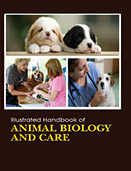Animal and Veterinary Science

Humans and animals have been inextricably linked even before animal domestication evolved over 11,500 years ago. Animals have played an important role in the provisioning of food, fiber, transportation, work, and companionship, and eventually as models for comparative research. This relationship carries significant social, cultural and moral responsibilities for the care and use of animals. It also mandates a deep understanding of animal biology, including physiology, health, behavior, and genetics, and of animal physical, cognitive and behavioral needs. Animal behavior is the bridge between the molecular and physiological aspects of biology and the ecological. Behavior is the link between organisms and environment and between the nervous system, and the ecosystem.
Illustrated Handbook of Animal Biology and Care investigates molecular and biochemical aspects of animal biology, such as genetics, cell structure, development and physiology. It also offers concrete guidance on best practices for promoting animal health in veterinary care, emphasizing specific techniques to prevent complications before they happen.
Animal Welfare is however, not only about ensuring an animal is not treated cruelly or caused unnecessary pain or suffering, it is about ensuring that an animal’s physical state, its mental state and its ability to fulfill its natural needs and desires are considered and attended to. Human concern for animal welfare is based on the awareness that animals are sentient and that consideration should be given to their well-being, especially when they are used for food, in animal testing, as pets, or in other ways. These concerns can include how animals are killed for food, how they are used for scientific research, how they are kept as pets, and how human activities affect the survival of endangered species.
Your purpose in studying animal biology is apparently either to broaden your general education or to equip yourself for some specific employment, e.g. as a doctor, a dentist, a veterinary surgeon, a school teacher, or perhaps a research worker in agriculture. In either event it is most important that you should have a clear idea of the primary objectives of biological teaching, and that you should endeavor at all times to prevent these from being submerged in a mass of details.